Key Takeaways
- In March 2009, Kansas State University successfully implemented the ELATEwiki website to encourage a public exchange of e-learning and teaching resources.
- ELATEwiki is a useful and growing resource available to faculty, students, and administrators in the higher education community.
- More than a learning objects repository, ELATEwiki fills a gap in existing resources and higher education community building.
- The project's greatest remaining challenge is to establish a long-term community of active users.
In early spring 2009, Kansas State University publicly released ELATEwiki, the Electronic Learning and Teaching Exchange. ELATEwiki facilitates the creation and documentation of innovative teaching approaches used by individuals and organizations interested in advancing the use of technology in teaching. This synergistic exchange currently hosts a wealth of freely available information categorized and organized into e-learning and teaching topics. It is useful to teachers, scholars, students, and administrators seeking to understand the dynamic and changing higher education landscape.
During the first few months following its release, the number of entries on ELATEwiki went from 0 to more than 150, and nearly 100 individuals have registered as users. Currently, the wiki receives 400+ visitors a day. As of September 2009, the ELATEwiki main page (see Figure 1) had received over 20,000 visitors.

Figure 1. ELATEwiki Main Page
Concept Origins
Traditionally, teaching was a face-to-face activity. As teaching moved into increasingly institutional settings, good practices became part of collective memory and were shared during hallway encounters, over lunch, in departmental meetings, within pedagogical publications, on college bulletin boards, through memos, and in many other ways. In a university's distance learning operation, sharing these practices became more complex and was more apparent in situations where instructors, administrators, and staff were geographically dispersed.
It was against this backdrop that ELATEwiki originated conceptually. Kansas State University's (K-State's) Distance Education Leadership group (of the Division of Continuing Education) recognized the need to better support e-learning faculty members. Geographically dispersed faculty members often "reinvented the wheel" and had no clear way of acquiring knowledge of successful practices employed by colleagues. Many felt isolated from the larger educational endeavors of the campus. Although several on-campus teaching exchanges existed, it became apparent that additional resources were required for teachers without easy campus access.
For approximately a year, the leadership group explored a variety of technologies and researched applications that might prove useful for supporting K-State teachers engaged in e-learning both on and off campus. In an environmental scan they explored existing virtual communities such as MERLOT, WikiEducator, and Curriki along with other content spaces. They reviewed various terms of service for online communities to identify potential legal concerns. As the discussions matured, the advantages of using a wiki became more apparent and more obviously relevant to the situation. Wikis provide wide access, digital content archiving, multimedia expressiveness, real-time updating, collaborative development, adaptability, and reversibility of postings.
The leadership group explored the webosphere to see what other educational wikis existed, how active they were, and what informational content each housed. Several wikis focused on e-learning technologies, but they had been designed for specific universities, subject areas, or courses. Other virtual communities focused on the exchange of curriculum material (often in the K–12 arena) or provided links to innovative projects and technologies. The search discovered a variety of education wikis that were mostly general in nature. Satisfied that an unfilled need existed, the team determined that a unique community-contributed and maintained dynamic repository of teaching and learning knowledge could be developed. They conducted a literature review to develop a working knowledge of wiki implementation and use.
In late 2008, the group achieved a humble budget (in the three digits) and administrative support to proceed. In early 2009, a small team formed and began to plan, create, and then launch a publicly accessible e-learning wiki. Originally envisioned as a resource for K-State faculty, the site soon expanded to include anyone with an interest in higher education. The group decided to go straight to live global accessibility instead of building to a closed environment and then transitioning to a public one, so all contributors would understand from the beginning that they were offering content to a global audience. The site's web presence was established January 23, 2009, and opened to public use March 23.
Brief Overview of Wikis
Wikis have become a solid fixture in the current Web 2.0 application pool representing a class of websites used to facilitate mass collaborative authoring. Most wikis provide features that allow users to create and edit content, develop topic or subject areas, link pages, and cross-reference material. Wikis are inherently flexible and can be used to display web content with the added bonus of allowing dynamic updating of content with a web browser. Wikis can be set up with a variety of user rights ranging from full public access to private access. Most wiki pages are primarily text-based, although more multimedia extensions are becoming available. When a page is edited, it displays as text with embedded HTML formatting options, although other options might also appear if various software extensions have been installed. As users make changes to a wiki page, the changes are tracked and a history record is created. This enables easily "backing out" of vandalism and inaccuracies. Over time, revision histories are created, and the latest version of a page displays as the current text.
Wikis also are considered a leading example of successful social constructivism1 and can become a mechanism for communal construction of knowledge, online discussion, and reflection. The collaboration fostered by wikis means they can become a hub for knowledge building in a community of users. The net result can be a synergistic increase in group learning rather than an individual quest for knowledge.2
ELATEwiki Implementation
After deciding to move forward with building an electronic learning and teaching exchange wiki, the K-State implementation team developed a strategy for ensuring a high-quality, useful website would result. A decision was made to use a Web 2.0 worldview overall to facilitate sharing intellectual resources and encourage users to contribute new material knowing that added content would remain available with a Creative Commons license. From K-State's perspective, this was an opportunity to share intellectual property and expertise while creating a wider digital footprint in the web's social sphere. The implementation strategy included the following aspects:
- Paradigm development
- Technological considerations
- Content ontology
- Risk assessment
- Sustainability
Paradigm Development
The implementation team engaged in a paradigm development that included brainstorming potential content and developing an identity as well as a look and feel for the website. Initially, the idea was to let the wiki evolve without building any structure or preconceived branches. The group focused on potential content areas such as curricular design, e-learning technologies, online teaching pedagogies, online learner support, professional development opportunities, teaching strategies, and regulatory concerns, among others. As we learned more about wiki features and the importance of making a wiki usable to an audience that might not have a technical background, we decided to develop a simple ontology that could later be expanded (see the subsection "Initial Content Ontology" below).
The implementation group discussed various naming options and after numerous suggestions determined that ELATEwiki (an acronym for Electronic Learning and Teaching Exchange) was suitable, memorable, and available as a domain name. K-State secured the domain and registered it for use as ELATEwiki.org.
K-State graphic artist Andrea Mendoza created prototypes for an ELATEwiki logo. The implementation team selected the logo shown in Figure 2 for use on the site.

Figure 2. ELATEwiki Logo Created by Andrea Mendoza, 2009
Wiki Software Selection and Installation
The implementation team researched and discussed various wiki software and hardware configurations before reaching an implementation decision. The team evaluated and compared wiki farms to K-State's own servers loaded with open-source wiki software. Among the considerations were server load, multimedia content inclusions, and future capabilities. Whether the site should be private, public, or a mix was discussed further. Issues regarding control and quality were investigated in more detail. A variety of wiki software systems were considered including Confluence, WetPaint, and phpWiki. Eventually the team reached a consensus to use MediaWiki, the open-source wiki technology underlying Wikipedia. This technology is in wide use and offers numerous multimedia extensions as well as easy methods to tag and categorize complex content. Further, MediaWiki is regularly updated and offers strong security features. K-State staff already had expertise with this software, had installed it for internal use on several past projects, and felt comfortable using it as the platform for ELATEwiki.
K-State's Office of Mediated Education (OME) installed MediaWiki software on a K-State server with a clustered environment having two nodes (to ensure a higher level of uptime). The server was prepared by preloading PHP 5.2.8 and MySQL database software, then version 1.13.3 of MediaWiki was loaded and configured.
Initial Content Ontology
According to Martin Hepp, Katharina Siorpaes, and Daniel Bachlechner, "Ontologies are unambiguous representations of concepts, relationships between concepts (such as a hierarchy), ontologically significant individuals, and axioms."3 The implementation team for ELATEwiki determined that an initial ontology should be developed to provide new users with a sense of order and a comfortable way to tag their content contributions and organize their material. The initial ontology was intended to be a simple starting point that users could expand into a more complex structure as the site grows and evolves. The team worried that potential users might fail to develop an initial contribution without a simple way to add value to the site and would not understand how to connect, display, or categorize their entries. Figure 3 provides a graphic view of this ontology and its main categories of instructors, tools, students, and course issues.
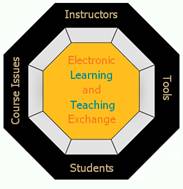
Figure 3. Initial Ontology for ELATEwiki
Instantiating the Initial Ontology
Using the ontology developed for ELATEwiki required configuring MediaWiki features appropriately. To do this, the team implemented the desired ontology in two dimensions:
- A macro structure
- User-developed subject tags and page linking
First, we developed a macro structure to provide an overall categorization of topics. This macro view grouped content into the four areas of instructors, tools, students, and course issues. Then these topics were instantiated with category tags, which also makes it possible for a particular content page to be a member of multiple categories. Figure 4 provides an example of a category tag viewed in ELATEwiki's edit mode for a page called Diigo.
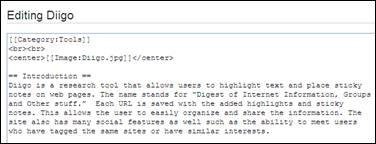
Figure 4. Editing an ELATEwiki Entry Categorized as "Tool"
To allow new or inexperienced users to easily develop an entry for one of the four major categories, hyperlinks were provided on ELATEwiki's main page navigation bar. Figure 5 illustrates.

Figure 5. Navigation Bar Links for Page Creation
Each hyperlink opens a new page template with inserted tags that would coincide with the site's initial ontology. The templates are MediaWiki wikitext page structures with features designed to make content easier to enter and to increase user productivity while eliminating frustration with technical details. Figure 6 provides a view of a template for Tools. Similar templates exist for the other three categories. While a structure is provided, the ELATEwiki team believed it was important to leave the content largely unstructured so that authors would have the freedom to develop material in a way that made sense to them. The only titles entered on the templates are for related pages, entitled "See Also" and "References." Additionally, pages can be added to the wiki using standard MediaWiki commands, without using the templates.
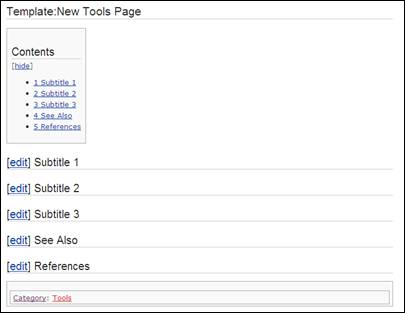
Figure 6. Template for Tools Page
The second dimension for the ontology involves user-developed subject tags and page linking. Figure 7 provides a list of categories currently in the ontology. Notice user additions such as Avatars, Course Management Systems, and Teaching Excellence. As these categories gain in membership and importance, the overall graphic ontology map can be expanded. The following links access the pages to create content for the four categories of courses, instructors, students, and tools:

Figure 7. User-Added Categories Supplement the Original Ontology
Additionally, users can add links to each page to provide transitions to related topics. Figure 8 provides an example in the "See Also" section of a page.

Figure 8. Links to Related Content Added to Wiki Pages
Over time, the implementation team believes users will attach more tags to their content. MediaWiki will automatically provide hyperlinks to groups of related articles this way.
Establishing Oversight and Quality Concerns
Wikis inherently generate a wide variety of challenges, particularly in the area of oversight and quality. Theoretically a wiki is intended to attract users and develop a sense of community that will enforce accuracy and ensure quality. However, with a new endeavor such as ELATEwiki, the implementation team believed human oversight would be required initially. In part this was due to the relatively small founding group and in part to the importance of maintaining academically sound contents. Management of a wiki can be time consuming and requires vigilance.
The implementation team designated a wiki master to handle administrative, nonacademic aspects of wiki management under one identity and to manage academic oversight under a second identity. I filled both these roles from early in the development process. My two systems operator accounts are with my academic name (ProfRogerMc) for content development and another name for maintenance and administrative oversight (WikiKeeper). The name "WikiKeeper" was meant to reflect community caretaking rather than a centralized domain master.
Preparation and Launch Strategy
After establishing the ontology and creating templates, the implementation team completed other housekeeping tasks to ensure users would find the site useful and easy to use. The Main Page sidebar was organized and then developed with wikitext to facilitate the user interface. Additional wikitext features automate new page creation and provide an overall view of all topics.
A multiphase launch brought ELATEwiki online. The first phase involved seeding the site with a number of articles to set the tone and provide immediate value to readers. As wikikeeper, I and a user with high privileges wrote and added articles to each of the categories in the ontology specifically to provide examples of various aspects of the site users might wish to emulate, such as image management, video inclusion, and various forms of linking. Several problems with formatting, titles, linking, and category creation were uncovered and fixed during this stage.
The second phase involved inviting a select group of on-campus e-learning experts to stress-test the wiki and create further content. They tested video inclusion, image management, and multimedia features during this time. Figure 9 provides an example of an embedded image on an ELATEwiki page, and Figure 10 provides an example of embedded video.
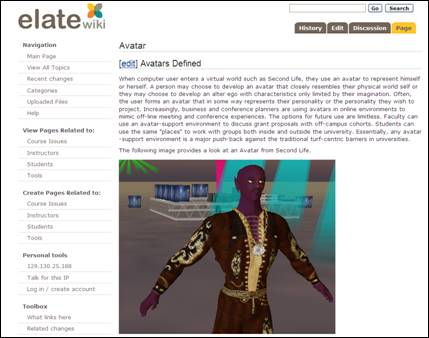
Figure 9. Embedded Image in ELATEwiki Page

Figure 10. Embedded YouTube Video in ELATEwiki Page
Also during the second phase, the K-State university attorney developed a legal disclaimer and Terms of Service for the site addressing a range of issues.
During the final launch phase the implementation team invited a wider community of users participate and began publicizing the site to the general public. We were certain the wiki was robust and could handle expected traffic. Invitations were sent via e-mail lists, at conferences, and through other channels. Additional features added to the site during this phase included extensions to enable:
- The export of RSS feeds from ELATEwiki to other sites
- ImageMagick to automatically generate thumbnail images and allow image scaling and resizing
- The reCAPTCHA plug-in for MediaWiki to eliminate spam and vandalism, which had grown to be an almost unmanageable problem as the site gained popularity (see Figure 11)
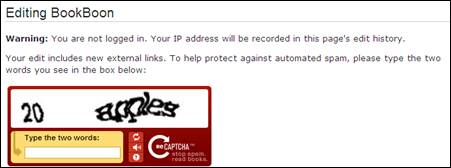
Figure 11. RECAPTCHA Plug-in for MediaWiki
Another feature added to ELATEwiki was the ANYSITE extension, which allows embedding a live website within a wiki page. This feature enables a preview of a related website or distribution of digital artifacts such as e-books. Figure 12 provides a view of ANYSITE being used with ELATEwiki partner BookBoon to distribute their library of free online textbooks.

Figure 12. Using ANYSITE to Distribute E-Books with ELATEwiki
Closing Comments on ELATEwiki
In the first five months after ELATEwiki soft-launched, the main and secondary pages of the website have experienced considerable traffic. While the implementation team is satisfied that the technical aspects of ELATEwiki are solid, the most daunting challenge remains: attracting a critical mass of users from which a community of practice will emerge.
Clay Shirky, in Here Comes Everybody: The Power of Organizing without Organizations, provides a perspective that might help in accomplishing this goal.4 (See also his blog, Here Comes Everybody.) Shirky suggests that for a social tool to succeed, achieving the correct balance between promise, tools, and bargain is a must.5 He suggests creating an intersection between governance and group dynamics/use and leveraging the resulting synergy to appeal to a critical mass of users. Shirky suggests "[t]he promise creates the basic desire to participate."6 In ELATEwiki, the promise becomes the willingness of potential users to take the plunge and contribute in meaningful ways, making their work accessible to appreciative peers. Additionally, contributors will have the opportunity to provide a valuable academic service for their students and the general public. The tools portion of the promise is more obvious: most tools are derived from MediaWiki's capabilities. Additional features such as the ontology, templates, categories, seeded entries, input boxes, and menus have been added to reduce the learning curve associated with use. As Shirky suggests, a good social tool must be designed to accomplish the task intended and fit the skill levels of those intending to use it.7 The bargain is the most complex aspect of the balance because it involves user behaviors in response to the promise and tools. For ELATEwiki, the bargain becomes that contributions will be maintained, improved, policed, and used by a community of peers. If the balance between promise, tools, and bargain is achieved, the project will experience a long and useful existence.
While K-State faculty and staff are committed to maintaining the site initially, we believe users will take on more roles as the site become more useful to them. This has already started happening on a limited scale as demonstrated by the number of new topics appearing and other contributions ranging from editing support to the appearance of new reference material. The K-State implementation team is working hard to ensure that a self-supporting, growing community of users will guide and develop ELATEwiki to its fullest potential.
Acknowledgments
Many thanks to the ELATEwiki Team. ELATEwiki exists because of the support of Dr. Sue Maes of the Division of Continuing Education (DCE) at K-State, whose office provided the funding. The development team (the DCE Distance Learning Leadership team) that created ELATEwiki included Dr. Roger McHaney, Dr. Bettie Minshall, Ellen Stauffer, Lynda Spire, Ron D. Jackson, and Dr. Shalin Hai-Jew. Josh Works provided critical back-end development. Andrea Mendoza created the evocative ELATE logo for this site. Thanks also to Peter Paukstelis, Scott Finkeldei, Dr. Vicki Clegg, Brent Anders, Josh McCune, and Dave Bollman for their support.
Questions regarding ELATEwiki can be addressed to Roger McHaney at [email protected].
- Michelle Notari, "How to Use a Wiki in Education: Wiki-based Effective Constructive Learning," Proceedings of the 2006 International Symposium on Wikis (New York: Association for Computing Machinery, 2006), pp. 131–132; and Joyce Seitzinger, "Be Constructive: Blogs, Podcasts, and Wikis as Constructivist Learning Tools," Learning Solutions e-Magazine, July 31, 2006.
- Kevin R. Parker and Joseph T. Chao, "Wiki as a Teaching Tool," Interdisciplinary Journal of Knowledge and Learning Objects vol. 3 (2007). pp. 57–72.
- Martin Hepp, Katharina Siorpaes, and Daniel Bachlechner, "Harvesting Wiki Consensus: Using Wikipedia Entries for Knowledge Management," special issue on Semantic Knowledge Management, IEEE Internet Computing, September 2007, pp. 54–65, see p. 55.
- Clay Shirky, Here Comes Everybody: The Power of Organizing without Organizations (New York: Penguin Group, 2008).
- Ibid, p. 260.
- Ibid, p. 261.
- Ibid, p. 269.
- Benkler, Yochai, The Wealth of Networks: How Social Production Transforms Markets and Freedom (New Haven, CN: Yale University Press, 2006/2007)
- Richardson, Will, Blogs, Wikis, Podcasts, and Other Powerful Web Tools for Classrooms (Thousand Oaks, CA: Corwin Press, 2006).
- Surowiecki, James, The Wisdom of Crowds (New York: Random House, 2004/2005).
- Tapscott, Don, and Anthony D. Williams, Wikinomics (New York: Penguin Group, 2008)
© 2009 Roger W. McHaney. The text of this article is licensed under the Creative Commons Attribution-Noncommercial-No Derivative Works 3.0 license.

